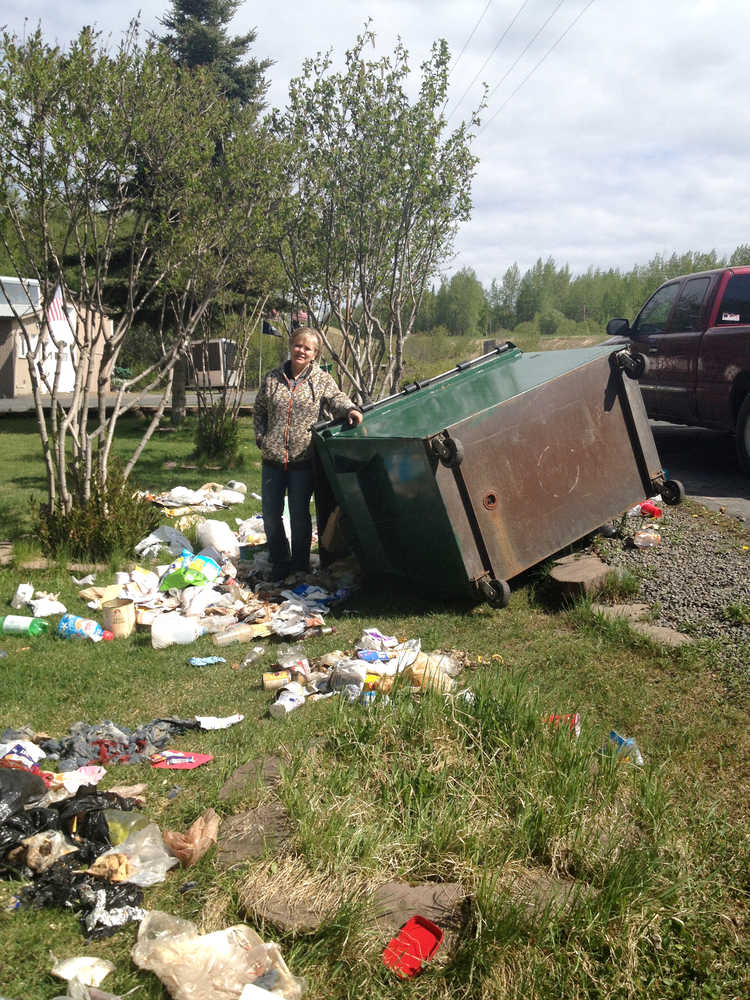The local office of the Alaska Department of Fish and Game has only received a handful of bear reports so far this spring.
While reports number fewer than previous years, bears are out and going through people’s trash.
Teea McBride, a Kenai resident who lives on Birch Street, said in an email Monday that a 5-foot tall black bear visited her yard recently and got into a bag of garbage.
Tom Bearup, who lives at Mile 91 of the Sterling Highway, said bears tipped over and went through his commercial-sized Dumpster. Bearup found the mess Monday.
“I mean the whole canister is in our front yard turned upside down,” Bearup said.
He said two brown bears have been sighted in his neighborhood recently, so he figures they’re the culprits. He said they left some scratch marks on the bin and scattered the trash around looking for food.
Jeff Selinger, area wildlife biologist with Fish and Game, has received about four brown and black bear reports in the last week to 10 days, but he doesn’t have an exact count.
He said the number is likely down due to a combination of factors.
“I think more and more people are being pretty diligent about minimizing attractants,” he said. … “Another (factor) is we’ve had … relatively high (bear) harvests the last few years. That could be removing some of the bears that have historically been coming into residences year after year.”
Even with the increase in harvests, other bears will come in behind the previous bears, he said, so residents need to make sure they don’t lapse in minimizing attractants. Selinger said people should try to make even less food available so bears in the area will pass through.
If the season follows the typical pattern, the department will likely see an increase in reports in the coming weeks, Selinger said.
“Generally as more bears come out of the dens and get more mobile, then we’ll start to see an increase in calls,” Selinger said. “It’s just real hard to predict. It’s variable from year-to-year.”
Moose calving has begun and generally peaks this weekend, he said.
He estimated about 3,000-4,000 moose calves are born on the peninsula each year.
He said sometimes Fish and Game will get reports about bears chasing moose and taking down calves near residences, but typically the department doesn’t get many reports like that.
“Usually when we deal with bear and human conflicts in the urban settings, around the cities and towns, it has to do with the bears getting attractants,” Selinger said.
He said to keep bear, moose and caribou issues low, Kenai Peninsula residents should make sure to minimize attractants including:
— Containing pet food and garbage in bear-resistant bins or enclosed areas;
— Keeping animals like chickens and rabbits in a safe area;
— Putting up electric wires for livestock or chicken coops;
— Putting birdseed and feeders away;
— Cleaning barbecue grills;
— Keeping dogs under control.
“Every year we have numerous issues with dogs chasing moose and moose calves and at times actually killing the calves — both moose and caribou,” Selinger said. “That’s the biggest thing right now and give (the animals) plenty of space.”
Selinger said Fish and Game appreciates bear reports to know where the bears are to track activity. The Soldotna-based department of Fish and Game can be reached at 907-262-9368.
If a bear is causing an immediate threat, Selinger said people should call law enforcement. However, if a bear is walking through a neighborhood and not causing any issues, Selinger suggests calling other residents in the area before calling authorities.
Kaylee Osowski can be reached at kaylee.osowski@peninsulaclarion.com.

